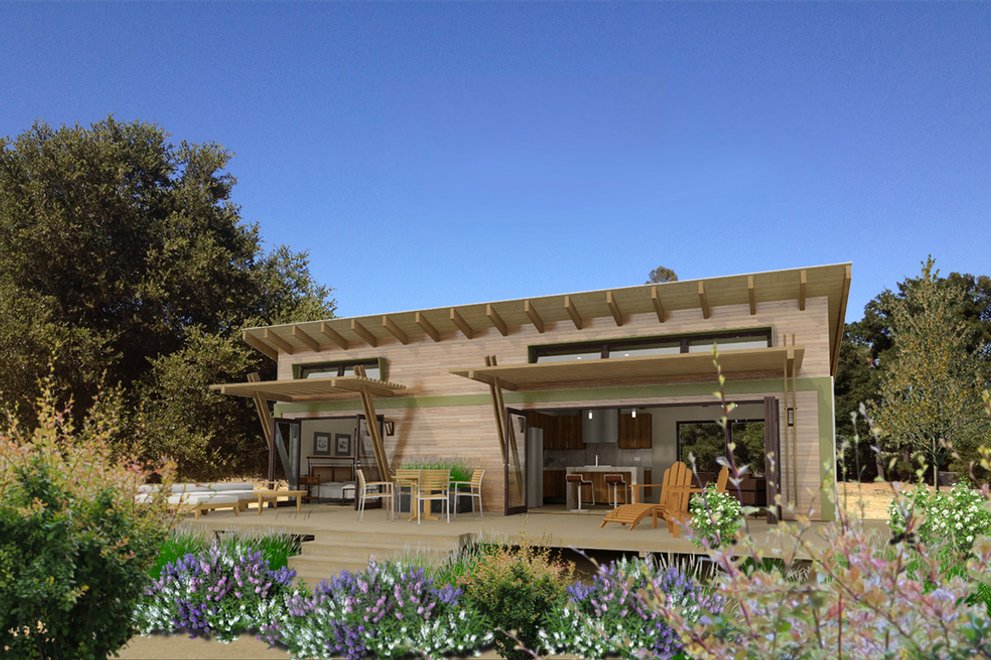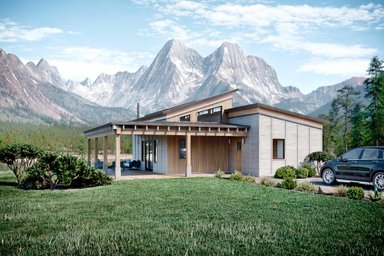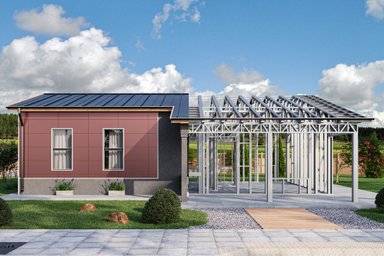It’s summer. Time to think about kicking back in the shade in your back
yard. Whether you’re considering installing a shade sail, pergola, awning, or
even buying some deciduous trees, here’s what you need to know when choosing shading structures.
Coverage
Brian Darnell, director of design and general contractor at Leap Adaptive in San Diego who has designed a
variety of plans with shade-making overhangs like his Plan 484-6 shown here, tells clients to select a shading device based on two key concerns, function and cost. “Function is almost always the first priority,” Darnell says, which means deciding why you need shade and then providing effective coverage where—and when—you need it. “Typically, you want to be able to cover a seating area for six people, and/or a small furniture grouping. An 8-foot dimension of shade is going to be minimal for a functional gathering space, and 10 to 12 feet is preferred. If you’re simply providing shading at a window system, then a 2 to 3-foot projection from your home can provide a nice shading coefficient,” he says.
It’s also important to think about the height of your shade structure above the shaded surface. Opinions on this point differ. “The higher you locate the cover, the less effective it becomes,” Darnell explains, adding that the aspect of relative scale to the building also needs to be considered. Darnell recommends a height of 8 to 10 feet for most shade structures and 12 feet for a very large structure. Jeffrey Gordon Smith of Jeffrey Gordon Smith Landscape Architecture in Los Osos, California, prefers higher ceilings outdoors. “I don’t think people are as conscious about scale in outdoor spaces,” Smith says. “Most people understand what an 8-foot ceiling is and are comfortable with indoor spaces, but an 8-foot ceiling in an exterior space is fairly claustrophobic. When I move to outdoor spaces, the ceilings, whether created by trees or structures, should be higher."
An additional factor to consider is whether your view will be framed—or cut off—by the height, width or depth of the shade structure. Smith and Don Crenshaw, owner of Shade Sails.com LLC, both recommend creating a 3-D model or string mock-up (or asking a professional to do so) before installation so that you can get a feel for what the final shade structure will look like before you build it.
Cost
“Someone may love an architectural sail type of canopy, but these constructions are typically expensive, unless they’re smaller scale and anchored to the existing building,” Darnell says. Smith adds that shade sails can cost more than you think due to the necessary structures and support materials, which can include poles and stanchions set into deep footings and lag bolts set into the home. According to Crenshaw, many housing communities now have strict building codes, and putting up a shade sail can require hiring a contractor and pulling a permit, which can double or triple the cost. Smith adds that retractable awnings are the most expensive shading option and require the most troubleshooting. “On the other hand, a simple timber trellis or pergola may fill your shading need nicely, and you can build it yourself with simple tools and materials from your local hardware store,” Darnell says. “Trees are also fantastic passive shading elements when easily integrated into the equation. They offer cooling shade, oxygen, kinetic energy and an almost interactive environmental habitat with birds, insects, squirrels and other tree dwellers.” Smith agrees, recommending deciduous trees that lose their leaves in winter when you want more sun entering your home.
Sun angle
Calculating the sun angle is an important factor when shading a space in your yard, Darnell says. This means thinking about how you will use your shaded space during different seasons and how effective your shading device will be at different times of year in relationship to the direction from which the sunlight is coming (the azimuth angle).
(Image courtesy of Sustainable Buildings Industry Council (SBIC) and the Beyond Green™ Guidelines for High- Performance Homes via "Sun Control and Shading Devices" from the Whole Building Design Guide.) “The size and shape of the shading device needs to take into account the purpose, sun angle and effectiveness sought,” Darnell says. “Too many times we see little eyebrow shading devices that do little or nothing to provide a solar shading coefficient. If you’re going to provide shade, make it meaningful, not a half-measure attempt to provide minimal protection.” A designer or landscape architect can easily help you calculate the sun angle for your shade structure and yard.
Materials
In general, Darnell recommends choosing a metal and fabric shade structure. He personally prefers powder-coated aluminum or medium-gauge steel with a tensioned Sunbrella® fabric (Sunbrella fabric fibers are saturated with UV-stable pigments, and the fabrics resist mold and mildew, can be easily cleaned with a bleach solution and are breathable). ShadeSails.com LLC is another option (example below and at the top of this post). Crenshaw says that his
company’s sails are constructed of high-density, knitted polyethylene fabric with UV stabilizers and SolarFix® thread (made of polytetrafluoroethylene [PTFE] fiber), and some are also fire retardant (photo courtesy Shade Sail LLC). He adds that the edge curves of his shade sails are designed in a specific shape that imparts equal tension into the membrane to avoid the wrinkles and droopy middles that people experience with some shade sail products. Coolaroo is another well-known provider of shade sails and exterior sun shades that are made of high-density, knitted polyethylene fabric.
Environmental Factors
Environmental factors can have a profound impact on selecting a shading device or structure, especially when in the presence of extreme conditions. For example, if you live in a high-fire zone, Darnell says do not use light timber structures that could create a combustible bridging element (you don’t want a timber structure expanding the threat of fire to your home when it’s near an area prone to wildfires). And if you’re located near the sea, Darnell says that type 316 stainless steel is the least corrosive metal you can use; any other metals will need to be powder coated or Kynar painted and will still corrode over time. Darnell also suggests vinyl, fiberglass, and acrylic as possible materials for your seaside shaded space, as well as wood, although even teak needs to be finished and painted regularly to protect it from the salt air. For those who opt for a shade sail, Crenshaw recommends that, if you live in a climate subject to tropical storms, such as Florida, you take it down during those storms. And, if you live in a climate that gets snow in the winter, such as Colorado, take your shade sail down when you winterize your yard and swimming pool because the knitted fabric may stretch under the weight of the snow.
Other Considerations
Is your shade device is structurally sound? Can it be easily adjusted? Smith considers shade sails somewhat permanent structures, like deciduous trees. While the fabric can be taken down and put away, the posts are usually permanent. Crenshaw adds: “Shade sail posts are 4-inch or 6-inch pipe and are 15 feet tall or higher. People request movable posts but they don’t work as well.” Crenshaw says too many people order triangle shapes that are 2-D flat planes instead of thinking in terms of 3-D forms like a potato chip (a hyperbolic paraboloid in math terms). Not only are these 3-D shapes more visually intriguing, but a 3-D load on the fabric is actually more sustainable in wind and doesn’t collect as much water. And don’t forget to put your shade sail under enough tension so that it doesn’t move in high winds and wear out faster.
Coverage
Brian Darnell, director of design and general contractor at Leap Adaptive in San Diego who has designed a
variety of plans with shade-making overhangs like his Plan 484-6 shown here, tells clients to select a shading device based on two key concerns, function and cost. “Function is almost always the first priority,” Darnell says, which means deciding why you need shade and then providing effective coverage where—and when—you need it. “Typically, you want to be able to cover a seating area for six people, and/or a small furniture grouping. An 8-foot dimension of shade is going to be minimal for a functional gathering space, and 10 to 12 feet is preferred. If you’re simply providing shading at a window system, then a 2 to 3-foot projection from your home can provide a nice shading coefficient,” he says.
It’s also important to think about the height of your shade structure above the shaded surface. Opinions on this point differ. “The higher you locate the cover, the less effective it becomes,” Darnell explains, adding that the aspect of relative scale to the building also needs to be considered. Darnell recommends a height of 8 to 10 feet for most shade structures and 12 feet for a very large structure. Jeffrey Gordon Smith of Jeffrey Gordon Smith Landscape Architecture in Los Osos, California, prefers higher ceilings outdoors. “I don’t think people are as conscious about scale in outdoor spaces,” Smith says. “Most people understand what an 8-foot ceiling is and are comfortable with indoor spaces, but an 8-foot ceiling in an exterior space is fairly claustrophobic. When I move to outdoor spaces, the ceilings, whether created by trees or structures, should be higher."
An additional factor to consider is whether your view will be framed—or cut off—by the height, width or depth of the shade structure. Smith and Don Crenshaw, owner of Shade Sails.com LLC, both recommend creating a 3-D model or string mock-up (or asking a professional to do so) before installation so that you can get a feel for what the final shade structure will look like before you build it.
Cost
“Someone may love an architectural sail type of canopy, but these constructions are typically expensive, unless they’re smaller scale and anchored to the existing building,” Darnell says. Smith adds that shade sails can cost more than you think due to the necessary structures and support materials, which can include poles and stanchions set into deep footings and lag bolts set into the home. According to Crenshaw, many housing communities now have strict building codes, and putting up a shade sail can require hiring a contractor and pulling a permit, which can double or triple the cost. Smith adds that retractable awnings are the most expensive shading option and require the most troubleshooting. “On the other hand, a simple timber trellis or pergola may fill your shading need nicely, and you can build it yourself with simple tools and materials from your local hardware store,” Darnell says. “Trees are also fantastic passive shading elements when easily integrated into the equation. They offer cooling shade, oxygen, kinetic energy and an almost interactive environmental habitat with birds, insects, squirrels and other tree dwellers.” Smith agrees, recommending deciduous trees that lose their leaves in winter when you want more sun entering your home.
Sun angle
Calculating the sun angle is an important factor when shading a space in your yard, Darnell says. This means thinking about how you will use your shaded space during different seasons and how effective your shading device will be at different times of year in relationship to the direction from which the sunlight is coming (the azimuth angle).
(Image courtesy of Sustainable Buildings Industry Council (SBIC) and the Beyond Green™ Guidelines for High- Performance Homes via "Sun Control and Shading Devices" from the Whole Building Design Guide.) “The size and shape of the shading device needs to take into account the purpose, sun angle and effectiveness sought,” Darnell says. “Too many times we see little eyebrow shading devices that do little or nothing to provide a solar shading coefficient. If you’re going to provide shade, make it meaningful, not a half-measure attempt to provide minimal protection.” A designer or landscape architect can easily help you calculate the sun angle for your shade structure and yard.
Materials
In general, Darnell recommends choosing a metal and fabric shade structure. He personally prefers powder-coated aluminum or medium-gauge steel with a tensioned Sunbrella® fabric (Sunbrella fabric fibers are saturated with UV-stable pigments, and the fabrics resist mold and mildew, can be easily cleaned with a bleach solution and are breathable). ShadeSails.com LLC is another option (example below and at the top of this post). Crenshaw says that his
company’s sails are constructed of high-density, knitted polyethylene fabric with UV stabilizers and SolarFix® thread (made of polytetrafluoroethylene [PTFE] fiber), and some are also fire retardant (photo courtesy Shade Sail LLC). He adds that the edge curves of his shade sails are designed in a specific shape that imparts equal tension into the membrane to avoid the wrinkles and droopy middles that people experience with some shade sail products. Coolaroo is another well-known provider of shade sails and exterior sun shades that are made of high-density, knitted polyethylene fabric.
Environmental Factors
Environmental factors can have a profound impact on selecting a shading device or structure, especially when in the presence of extreme conditions. For example, if you live in a high-fire zone, Darnell says do not use light timber structures that could create a combustible bridging element (you don’t want a timber structure expanding the threat of fire to your home when it’s near an area prone to wildfires). And if you’re located near the sea, Darnell says that type 316 stainless steel is the least corrosive metal you can use; any other metals will need to be powder coated or Kynar painted and will still corrode over time. Darnell also suggests vinyl, fiberglass, and acrylic as possible materials for your seaside shaded space, as well as wood, although even teak needs to be finished and painted regularly to protect it from the salt air. For those who opt for a shade sail, Crenshaw recommends that, if you live in a climate subject to tropical storms, such as Florida, you take it down during those storms. And, if you live in a climate that gets snow in the winter, such as Colorado, take your shade sail down when you winterize your yard and swimming pool because the knitted fabric may stretch under the weight of the snow.
Other Considerations
Is your shade device is structurally sound? Can it be easily adjusted? Smith considers shade sails somewhat permanent structures, like deciduous trees. While the fabric can be taken down and put away, the posts are usually permanent. Crenshaw adds: “Shade sail posts are 4-inch or 6-inch pipe and are 15 feet tall or higher. People request movable posts but they don’t work as well.” Crenshaw says too many people order triangle shapes that are 2-D flat planes instead of thinking in terms of 3-D forms like a potato chip (a hyperbolic paraboloid in math terms). Not only are these 3-D shapes more visually intriguing, but a 3-D load on the fabric is actually more sustainable in wind and doesn’t collect as much water. And don’t forget to put your shade sail under enough tension so that it doesn’t move in high winds and wear out faster.






